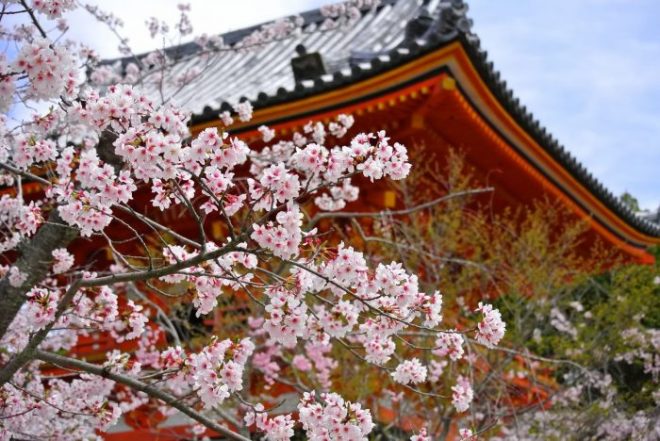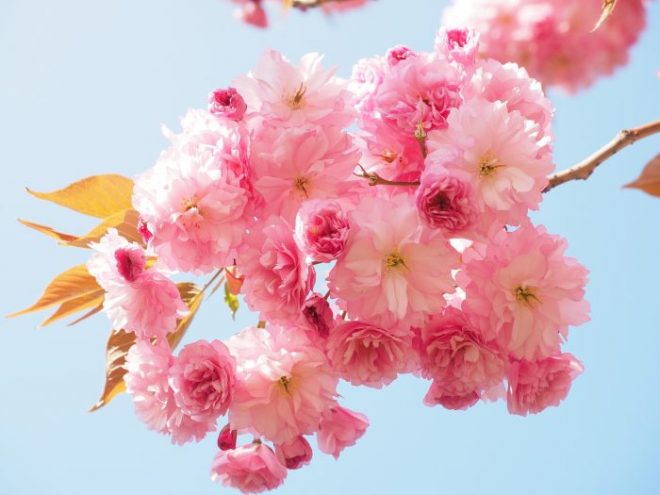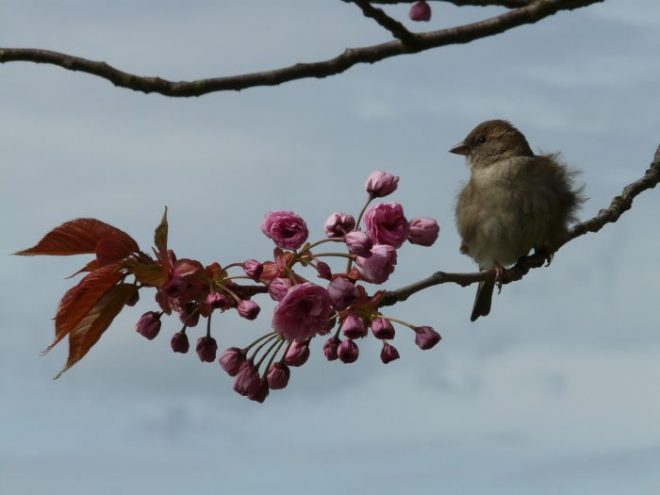お花見について英語で話そう
~しだれ桜は英語で?~

今回は日本の文化である「お花見」に焦点を当て、
1. お花見にまつわる基本英単語
2. 桜の種類を英語で
3. お花見をするときに使えるフレーズ
4. 桜を表す日本語表現を英語で
の4つについてご紹介したいと思います。
目次
お花見にまつわる英単語

・cherry blossoms / cherry trees (桜の花 / 桜の木)
「桜の花」と言いたいときは “cherry blossom”、「桜の木」と言いたいときは “cherry trees” を使います。
・cherry blossom viewing(お花見)
お花見は英語で “Cherry blossom viewing” と言えます。ただ、お花見の文化(桜を見ながら食事をしたりすること)を知らない人に説明するときは “Let’s eat lunch and enjoy flowers.”(お昼を食べながら桜を見よう)のように、具体的にすることを伝えるとさらに分かりやすいです。
近頃は外国人にもお花見が認知され、単純に “Hanami” と言っても伝わることも多いようです。
ちなみに、「夜桜を見に行きたい」というのは、”I want to see cherry blossoms at night.” で表せます。
・save the spot(場所取りをする)
お花見に欠かせない場所取りは “save (a good / the best) spot” と表します。”good” や “best” をつけて「良い場所」「最高の場所」などと表現することもできます。
・buds(つぼみ)/ full bloom(満開)/ flowers mixed with the leaves(葉桜)
「つぼみ」「満開」「葉桜」はそれぞれ上記のように表せます。
「つぼみ」は英語で “buds” ですが、この単語自体は会話の中であまり使われません。「まだ満開ではない」という言い方がより自然です。
また「葉桜」は「花が散り、若葉が出てきている状態」と捉えて “flowers mixed with the leaves” と表せます。(若葉自体は “new leaves” と言います)
<例文>
- I heard the cherry blossoms haven’t bloomed yet.
(桜はまだ咲いていない(まだつぼみ)って聞いたよ) - The cherry blossoms have finally bloomed. They are going to be in full bloom soon.
(やっと桜が咲いたね。もうすぐ満開になる。) - Unfortunately, most of the petals have already fallen. There are still some flowers mixed with the leaves though.
(残念だけど、ほとんど桜散ってしまったね。葉桜はあるけど。)
桜の種類
桜の種類は日本国内だけでも600以上あると言われています。今回は代表的な3つを取り上げました。
ソメイヨシノ(Somei Yoshino)

日本で一番よく見かける桜がこのソメイヨシノです。北海道から九州まで、広い範囲に分布しています。5枚の花びらを持ち、白に近い薄ピンク色をしています。
In Japan, the most common type of cherry blossoms are Somei-yoshino. They are widely distributed from Hokkaido to the Kyushu area. They have five petals and are a shade of pale pink very close to white.
八重桜(Yaezakura)

花びらが幾重にも重なって咲くものが八重桜です。(多いもので300枚近くなるものもあるそうです!) 辞書では “double-flowered cherry blossom” と出てきますが、”fuller cherry” や “fluffy cherry” と表しても伝わります。
The cherry blossoms which bloom with many petals are “Yaezakura”. (Sometimes there are as many as 300 petals.) The dictionary says “Yaezakura” can be translated as “double-flowered cherry blossom”. You can also say “fuller cherry” or “fluffy cherry”.
しだれ桜(Shidarezakura)

しだれ桜(枝垂れ桜)の枝は長く柔らかいので、このように緩く垂れかかるそうです。この姿が悲しげに見えることから、すすり泣きを表すweepを用いて”weeping cherry trees”と呼ばれます。
The branches of Shidare-zakura are so soft and long that they bend loosely. Because this looks like they are in a sad mood, we call them “weeping cherry trees” by using the word “weep,” as it means to shed tears.
お花見で使えるフレーズ

次に、お花見で使えるフレーズを5つご紹介します。
It looks like the cherry blossoms are in full bloom. I think Osaka castle is the best place to go.
桜が満開みたい。大阪城公園が最高だと思う。
The forecast is really good. It’s supposed to be sunny.
天気予報すごくいいよ!晴れるみたい。
This place can be really crowded. We should get there early to get a good spot.
この場所はすごく混むかもしれないね。場所取りのために早めに行っておこう。
Would 10 o’clock be okay? I know it’s a little far for you.
10時って大丈夫?ちょっと遠いと思うけど。
I’ll bring the food. Could you take care of the drinks please?
食べ物持っていくね。飲み物お願いできる?
桜を表す日本語表現
最後に、桜を表す日本語表現をどのように英語で表現できるか見ていきましょう。桜にまつわる美しい日本語がたくさんありました。今回は2つご紹介します。
花曇り(Hanagumori)

「桜が咲く頃のうっすらと雲がかかった天気のこと」
“Hana” は花、”Gumori”は曇りを意味します。”Hanagumori”は春のかすんだ天気(どんよりとした曇り空ではなく)を表します。桜が咲く頃の薄い雲の空を説明する、この時期特有の言葉です。
“Hana” means flower and “Gumori” means cloudy weather. “Hanagumori” describes hazy weather in spring (not heavy clouds). This word is very specific. We only use it to explain this thin cloud in this season when cherry blossoms bloom.
花吹雪(Hanahubuki)

「花びらが乱れ散るさまを吹雪に例えた言葉」
“Hana”は花、”Hubuki”は吹雪を意味します。風が吹き花びらが散るとき、花びらは雪のように宙を舞います。
“Hana” means flower and “Hubuki” means blizzard. When wind takes some petals away from the trees, they swirl around in the air like snow.
今年も例年のようなお花見は難しそうですが、新しい形のお花見を楽しんでいけたらと思います。
See you next time!



